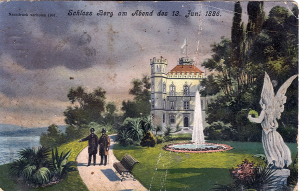
Germany’s Greatest Unsolved Mystery
We know him as the “Fairy Tale King” and the “Swan King.” Some also call the “mad king of Bavaria,” but psychiatrists today debate whether he really was insane. He was the patron of Richard Wagner and the builder of Neuschwanstein, the alpine castle that inspired Walt Disney’s Sleeping Beauty Castle. If that wasn’t enough to make him the stuff of legend, his death certainly was. It became Germany’s greatest unsolved mystery. Almost 130 years later, historians still can’t decide what happened.
Let’s take a closer look at that fateful day of June 13, 1886 on Lake Starnberg, southeast of Munich. But a bit of background is necessary to understand why some people wanted Ludwig II off the throne.
An Unconventional Reign

Ludwig II ruled Bavaria from 1864 to 1886. Always more interested in the arts than governing, he increasingly withdrew from Munich, the Bavarian capital, to live in his beloved alpine countryside. Ludwig avoided crowds and refused to host royal balls and banquets. His abhorrence for social gatherings was so great that he even avoided public theaters, preferring private performances put on for an audience of one.
His private money that he might have spent on royal functions went instead to fund magnificent castles and palaces in the foothills of the Alps: Neuschwanstein, Herrenchiemsee, and Linderhof are now considered architectural jewels of Bavaria and draw millions of tourists. But Ludwig ran out of money, and a 7.5 million mark bank loan likewise slipped through his fingers. By 1886, the king was 14 million marks in debt and creditors began to take legal action against him.
How Bavarian Ministers Deposed Ludwig II
Hoping to avoid a crisis for the government, Bavarian ministers hatched up a plan to oust Ludwig II and found a legal method in the Bavarian constitution: a king could be removed if found insane.

They collected witness statements about Ludwig’s eccentric behavior and presented it to a panel of psychiatrists. But there was a catch. The psychiatrists had to make a diagnosis without examining their patient: There was no way Ludwig would have consented to a psychiatric evaluation.
Based on the evidence they had, the physicians declared Ludwig insane. That was all the ministers needed. They proclaimed Ludwig’s uncle regent and had Ludwig taken into custody in Neuschwanstein. They transferred the deposed king to the castle Berg on Lake Starnberg on June 12, 1886 for psychiatric supervision and evaluation.
The Most Controversial Death in German History
The following day, Ludwig took an evening walk with his psychiatrist, Dr. von Gudden. The physician felt safe with the king and sent an orderly, who was to accompany them, back to the castle. The two were to return by 8:00 p.m.

When they didn’t, a search party began scouring the castle grounds. At 10:30 p.m., the party found Ludwig’s jacket, overcoat, hat, and umbrella on the lakeshore and in the shallows. Gudden’s hat and umbrella were also nearby. The search continued by boat. At 11:10 p.m., the party found both bodies floating lifeless, in the dead man’s float, 20-25 paces from shore in waist-deep water. Both were fully clothed and wearing shoes.
Footprints found the next day indicated a struggle. Then the king’s footprints led into deeper water.
A later autopsy concluded that Gudden died from drowning. The king’s autopsy was inconclusive about the cause of death, but claimed to have found organic brain changes indicative of insanity (doctors still dispute the significance of those findings today). The king appeared uninjured, but the doctor had a head injury and torn fingernail.
Summary of popular competing theories about the death of Ludwig II
Accident
- Struggle with Gudden over attempt to escape or commit suicide
- King killed Gudden in the struggle
- Heart attack due to water temperature and recent ingestion of alcohol
Suicide
- Ludwig II had previously expressed suicidal thinking
- King fled into the water to drown himself
- Doctor attempted to stop him and died in the process (injury or exposure to cold water)
Murder
- King attempted to escape, struggled with Gudden
- Someone shot Ludwig II in the back as he waded to a waiting boat

The official government version was suicide by drowning. Some witness statements that came years later support the murder theory. Everyone who helped recover the bodies was forced to swear on a crucifix and Bible never to say anything about that night, not even on his deathbed. And that alone might indicate a cover-up. Some even say the autopsies were a cover-up.
I find it strange that that both bodies were found floating. Usually drowning victims sink fast, especially when water-logged clothing and shoes pull them down. There is such a phenomenon called dry drowning, in which a larynx spasm suffocates the victim. Gary Haupt, with the Missouri Water Patrol writes, “If a corpse does not sink, investigators should suspect another cause of death, such as heart attack. Or, perhaps, a dry drowning has occurred; in those cases, because the lungs do not contain water, the body will not descend.”
Might that indicate a murder? We will never know.
Ludwig II once expressed his hope that his life would be an “eternal enigma.” If he hadn’t achieved that within his lifetime, he certainly did with his death.
What do you think might have happened?
Read another post about why Americans might have the evidence needed to clear up Ludwig’s death.
Literature on point:
Alfons Schweiggert & Erich Adami, Ludwig II. Die letzten Tage des Königs von Bayern (Munich: MünchenVerlag 2014)
Christopher McIntosh, The Swan King: Ludwig II of Bavaria, revised ed. (London: I.B. Tauris 2012)
Gary Haupt, Drowning Investigations, Missouri Water Patrol




Ludwig is buried at St Michael’s Church, but where is the doctor buried?
Have they ever dug up the bodies and examined them? Would that show if Ludwig was shot or not? I’ve read that the family won’t allow Ludwig to be examined, but maybe the doctor’s body may hold some clues?
That’s an excellent question, Brian! Dr. Berhard von Gudden is buried in the Ostfriedhof of Munich, and at least according to a German Wikipedia site, his grave is still there (Germans often re-use graves, but apparently von Gudden was important enough to deserve a permanent grave). As far as I know, there has been no call for exhuming von Gudden’s body. Many adherents of the murder theory think he was strangled, so that the body today wouldn’t offer any clues. If Ludwig indeed was shot, one might be able to find lead or skeletal damage to corrobroate the theory. The House of Wittelsbach, however, opposes an exhumation. Pehaps Bavaria prefers the mystery over the truth.
I think if there is foul play involved, the doctor should be examined too. Maybe he was drowned, maybe that was a lie. Maybe they even swapped bodies when they buried them — ok that sounds crazy but I can think of some reasons to do it.
Another thing – when you take a tour of Neuschwanstein, remember that in a sense you aren’t welcome! King Ludwig left instructions to destroy the castle after his death. (Better to destroy it than have the likes of you walking around in it.) Luckily, the powers that were decided to open it to tourists instead.
As to Dr. Gudden — who knows? It might be worth a try. It’s too late to bring anyone to justice, but clarification of history is a worthy goal. President Taylor’s body was exhumed for the same reason in the 20th century: to check whether he was poisoned or not.
Ludwig’s castles caused debt problems when they were built, but now they’ve repaid themselves many times over by generating tourism income. I’ve visited the castle, but it doesn’t bother me that the king wouldn’t have wanted me there. It’s more interesting how a Ludwig myth has developed. In that regard, he’s comparable to Princess Diana.
[…] Searchers found them dead several hours later, floating in shallow water near the shore. A previous blog post covers the death in more […]
[…] It all happened during an attempt to depose Ludwig II in June, 1886. Bavarian officials arrested king and placed him under custody at the castle Berg on the shore of Lake Starnberg. You can read more about the king’s life, the arrest, and the circumstances of his death here. […]
I visited Neuschwanstein and became intrigued with King Ludwig II, partly due to compassion, partly due to his sensitive artistic side. I don’t believe he was mad, at all, simply caught in the tragic circumstance of his life, being unable to openly be who he truly was. As well, this title was thrust upon him at a very young age, what a huge responsibility. . I do believe he was murdered. Perhaps poisoned. On the other hand, it is quite likely that he would not have been able to endure what lay ahead, once declared insane and dethroaned, and simply ended his own life. What is odd, is that Ludwig’s jacket and overcoat were removed. Had he wanted to take his own life, by drowning, he certainly wouldn’t have taken them off. Other accounts state that he had no water in his lungs, and that the Doctor had marks on his neck that indicated he had been choked. It even occurred that perhaps this Doctor was going to help him escape, and they were both murdered. After all, the Doctor sent the person, who was to accompany them, back. Perhaps someone suspected, and took it upon themselves to take matters into their own hands. We shall never know. Perhaps a 1,000 years from now, someone will exhume the body, in the same fashion that the ancient Egyptian tombs are shamelessly raped, and find the answer to the mystery that still remains.
Thanks for your thoughtful comment, Sarah. One of the things that makes this case so intriguing, from an investigative perspective, is that the evidence can be interpreted in a variety of ways. Perhaps Ludwig slipped out of his overcoat and jacket because Dr. Gudden had grabbed him. But two things are particularly disturbing, an apparent gag order on the witnesses after Ludwig’s death and the dry drowning. If I recall, neither Ludwig nor the doctor had water in their lungs. Dry drowning is a known phenomenon; it’s rare, so if two people die from dry drowning that should be a red flag to investigate the case further.
You are right; we will probably never know. That adds to Ludwig’s mystic and popularity today.
I agree, silencing everyone certainly points to foul play. It’s said that he was a large man, by that age, and if there was a struggle, certainly Ludwig over-powered him. So, in the tussle,Ludwig chokes the doctor (who had a gun, let’s say), then pulls his overcoat and jacket off, to swim away the lake, in hopes of escaping. Someone else comes up, takes the gun that the doc had intended to use, and shoots Ludwig as he is starting to swim across the pond. So many possibilities and, indeed, the unknown is always intriguing in the numerous ponderings that captivate the mind.
I meant to add that I think it is interesting that there remains a knighthood, of sorts, that still attempts to solve the mystery. Reminds me of the many scenarios the search for the Holy Grail has carried on, century after century, ‘though Ludwigs death wasn’t so very long ago, considering the passage of time. .
The Guglmänner certainly add to the mystique, don’t they? There are three things that make Ludwig II so fascinating: his own life, his mysterious death, and the Ludwig cult that has sprung up since his death.
[…] Today the Guglmänner have shifted their focus to clarifying the mysterious circumstances of a King Ludwig’s death, which they believe was murder. They gather evidence about his death, fight for further investigation, and gather, shrouded in black, at his grave and the site of his death, to pay their respects. You can read more about Ludwig’s death here. […]
Why not use x-ray backscatter to scan the body in its grave to see what evidence can be gleaned from that?
That’s an interesting idea, Fritz. King Ludwig II is buried in the crypt of St. Michael’s church in Munich in a metalic sarcophagus (zinc with gold plating). I doubt an X-ray would penetrate it. The doctor is buried in a cemetery, I believe, but one would have to check to see whether such an X-ray examination in a cemetery would violate German law. I suspect it might.
The Guglmänner did an interesting examination of Ludwig’s sarcophagus several years ago. If you can read German, you might enjoy this link.
As long as it’s not too thick, X-rays can be made to penetrate it. The frequency and the energy levels of the X-rays may have to be specifically tuned for the task. This will be especially tricky because you really need soft X-rays to handle the soft tissues (or what’s left of it) but the harder X-rays to penetrate the metal used in his sarcophagus. So one may have to get tricky to pull it off.
I will take a look at the link you provided. Mein Deutsch ist klien. Danke.
As far as German Law is concerned, that would be interesting. I doubt if they have anything specifically on X-rays in crypts, but never doubt the power of the lawyers to find new ways to interpret old laws that don’t really apply!
That’s interesting! I didn’t know some X-rays can penetrate metal.
Germany has pretty strong rights of privacy that endure beyond a person’s death, so the courts might frown on someone trying to view the contents of someone’s grave via X-ray. Those rights usually last only 70 years beyond death. But because Germany outlaws metal detectors, there could be problems with ground-penetrating X-rays. But it’s something for Germans to consider as a step in further investigating King Ludwig’s mysterious death. Thanks for your comments!
For some years ago I read at the internet somewhere, that King Ludwig’s jacket was hidden in a private home after the found of his body, because there was a hole after gunshot and therefore the jacket wanished from the area. I Think the history came from a family to a servant whom had been at the lake “for cleaning up”! But I have not seach for finding the words again, and if the heart has been removed from the body, the hole, if one from a gunshot, they could have destroyed it by “accidence”!
Yes, I’ve read that same story too, but the jacket was supposedly stolen, which makes it difficult to know if the story is true or not. But as to a second autopsy, it’s still possible that something could be discovered. A bullet might have still been in the body, or it might have nicked bone tissue, leaving marks. But there’s no guarantee that anything would be found. Thanks for commenting — Ludwig’s death is fascinating if nothing else.
…His own familiy Kill him. Ludwig II it was to be King of Germany. It was a familiar complot. It was a Crime a State Crime!! The entire world would be different if Ludwig would have been King of Germany.
I’ve read some interesting commentary on whether WWI would have occurred if Ludwig II had remained king. It’s all speculation, of course, but yes, in some sense the world would have been different if not for his untimely death.
[…] to suicide, homicide, and various forms of an accident. You can read more about the mysterious case here, and for the reasons many Bavarians think it was murder, click […]
[…] Germany’s Greatest Unsolved Mystery […]